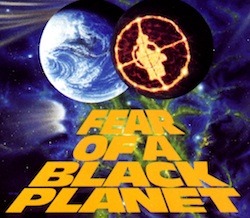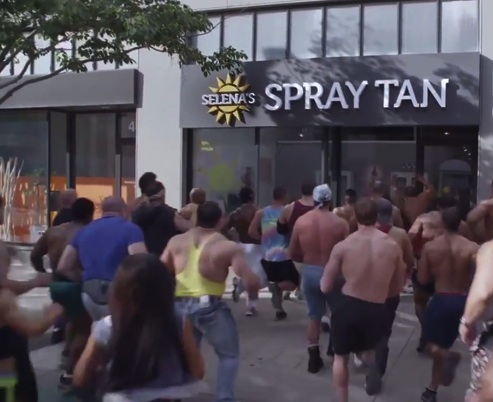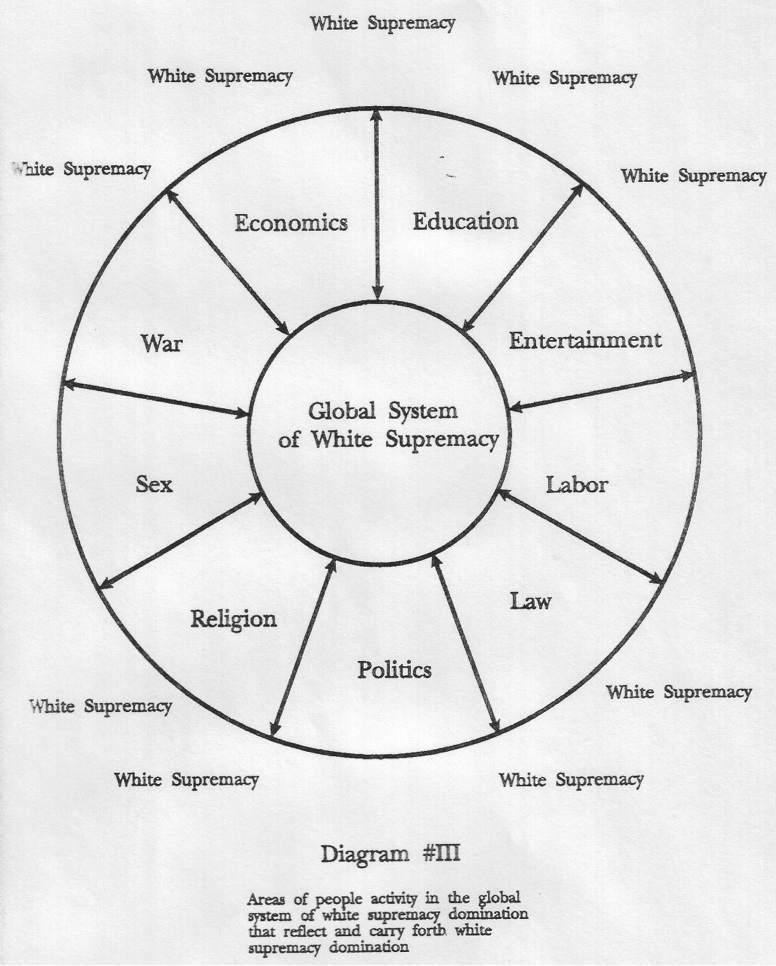NPR Asks 'Why do We Have So Many Terms For 'People Of Color?' [Answer] to Practice Racism & Maintain Control of Non-whites
/
Surrounded by a Non-White Global Majority, White People Struggle with what to call Non-whites. The following article from NPR entitled "Why We Have So Many Terms For People Of Color" is about Canada's recent decision to identify non-white people as "racialized people." This article as with all others concerning people of color should be considered in the context of racism/white supremacy. Decontextualizing issues pertaining to us is a dangerous form of deception. Through such a lens the title of the article could be properly decoded to say, "Why White People Have So Many Terms for People of Color." In the video below, Neely Fuller teaches that racists always do the classifying. The victims of white supremacy (non-whites) cannot classify themselves without their approval. Where do you think the terms "Africa", "African", "Latino," "Burma", or "Redskin" came from?
According to Dr. Blynd, race is an artificial "European" invention with real consequences. Race is not real but racism is. Race has been created to be wrongly confused with ethnic identity in order to establish the sense of "otherness" and dehumanization of melanated peoples around the globe. [MORE] The only purpose of race is to practice racism. Racism is a conventional reality than non-whites must deal with and eventually confront.
Racism is white supremacy. White supremacy is the only functioning form of racism there is- as there is no place in the world where non-whites dominate whites or are operationally or functionally in control of white people. 'Everywhere one finds Whites and Blacks in close proximity to each other, whether it is Chicago or Zimbabwe, the Whites are in control. This extraordinary universal phenomenon which defies every known statistical law of probability is rarely questioned.' [MORE] and [MORE]

Dr. Frances Cress Welsing's Color Confrontation theory explains that white people are motivated to practice racism due to their numerical inadequacy and color deficiency or color desire. White people are vastly outnumbered throughout the world and they can be genetically eliminated by intermingling or having sexual relations with non-white people. That is - White plus Black equals Colored. White plus Brown equals Colored. White plus Yellow equals Colored. Her theory also explains that consciously or subconsciously whites do not like their physical appearance (lack of melanin and skin color) which causes great anxiety, inferiority complex and inner hate or hostility - they compensate for this perceived inadequacy in various ways. [MORE]
White people are the vanishing majority in the U.S. and are surrounded by a non-white global majority - whites now represent less than 10% of the world's population --and their numbers continue to diminish. 90% of the world is non-white. [MORE] and [MORE] and [MORE]. These characteristics of whites have remained constant and fuel white supremacy. White people practice racism to survive.

Divide, frictionalize and conquer through confusion & deception. Welsing states, "the Color-Confrontation theory further postulates that whites are vulnerable to their sense of numerical inadequacy. This inadequacy is apparent in their drive to divide the vast majority of non-whites into fractional, as well as frictional, minorities. This is viewed as a fundamental behavioral response of whites to their own minority status. The white "race" has structured and manipulated their own thought processes and conceptual patterns, as well as those of the entire non-white world majority, so that the real numerical minority (whites) illusionally feels and represents itself as the world's majority, while the true numerical majority (non-whites) illusionally feels and views itself as the minority.
Interestingly, the white collective, whenever discussing the question of color [for example see article below], never discusses any of its own particular ethnic groups as minorities, but constantly focuses on the various ethnic, language and religious groups of non-white peoples as minorities. Then great efforts are made to initiate conflict between these arbitrary groups. This is one of the key methods by which a minority can remain in power. The "divide, frictionalize and conquer" pattern, observable throughout history wherever non-whites are confronted by whites, results primarily from whites' sense of color deficiency and secondarily from their sense of numerical inadequacy. This pattern, then, is a compensatory adjustment to permit psychological comfort through dominance and control. [MORE] Without further ado, below is the NPR article:
From [HERE] Last week, the Toronto Star found itself in the midst of one of those blink-and-you-missed-it Internet kerfuffles over race.
Here's what happened. The Ontario Human Rights Commission had settled on a term to use in reference to people of color — "racialized people."
The commission wrote:
"Recognizing that race is a social construct, the Commission describes people as 'racialized person' or 'racialized group' instead of the more outdated and inaccurate terms 'racial minority,' 'visible minority,' 'person of colour' or 'non-White.' "
In turn, Star reporter Natasha Grzincic created a listicle: "5 other labels for people of colour er... non-whites uh ... racialized people." It seemed to be riffing on a common idea that these designations are tortured and overly sensitive.
Some readers complained that Grzincic was making light of the agency's decision, and the story was subsequently removed from the Star's website a few hours later, with a note saying that it did not meet the paper's standards.
On this side of the border, the Army found itself in hot water after it updated its regulations to prevent discrimination, noting that some people who are "black or African-American" might also identify as "Negro." The story was widely reported as Army says 'Negro' is OK to use, and although that's not exactly what happened, the Army felt compelled to issue an apology and remove the motive. (You might recall a similar controversy over "Negro's" appearance on U.S. Census forms that prompted the bureau to announce last year that it would be removed from future questionnaires.)
Minorities. Nonwhites. People of color. In some corporate-esque sectors, you might even hear someone use the term "diverse" as a modifier — as in, "We're really interested in hearing a diverse voice on this issue," as though an individual person might be diverse. Each of those terms came into wide usage in the 20th century, only to fall out of vogue and be replaced with a new one. Each replacement was meant to be less loaded than its predecessor, only to eventually take on all of that predecessor's anxieties — and some new ones. Linguists refer to this process as "pejoration."
"If a word that refers to something always appears in sentences where that thing is framed negatively, then that term will take on that negativity," Lauren Hall-Lew, a sociolinguist at the University of Edinburgh, told me over email.
Steven Pinker gave this idea a more colorful name in his 2004 book The Blank Slate: the "euphemism treadmill."
"The drive to adopt new terms for disadvantaged groups ... often assumes that words and attitudes are so inseparable that one can re-engineer people's attitudes by tinkering with the words," Pinker wrote.
He went on:
"People invent new words for emotionally charged referents, but soon the euphemism becomes tainted by association, and a new word must be found, which soon acquires its own connotations, and so on. [...] Even the word 'minority' — the most neutral word label conceivable, referring only to relative numbers — was banned in 2001 by the San Diego City Council ... because it was deemed disparaging to nonwhites. ... The euphemism treadmill shows that concepts, not words, are primary in people's minds. Give a concept a new name, and the name becomes colored by the concept; the concept does not become freshened by the name, at least not for long. Names for minorities will continue to change as long as people have negative attitudes toward them. We will know that they have achieved mutual respect when the names stay put."
These terms also become outmoded because of our shifting politics. A designation like "nonwhite" is often criticized because it makes white people a kind of neutral default from which other people might deviate. A term like "minority" might ruffle some folks because we're entering the age of pluralities, with no clear majorities.
That same volatility dogs more specific racial designations than those describing all people of color. As I wrote in a story some months back, Americans often change which boxes they checked for the race question on the United States census. Indeed, the Census Bureau said no two decennial censuses have ever used the same language or categories for questions about race or ethnicity.
"Oriental" became "Asian" became "Asian-American and Pacific Islander." "Colored" changes to "Negro" and then to "black" and "African-American." The nomenclature for white people, on the other hand, has remained more or less stable, even if the definition of who might qualify as "white" has been pretty fluid over the past few hundred years.
But as Hall-Lew points out, this is all less about the words themselves than about the social context in which they're being used. "Colored" is an ugly anachronism in the United States but still a pretty neutral descriptor in South Africa, where "Coloured," with a capital C, refers to people with certain mixed-race ancestries. "Despite the extremely fraught history of racial tension in South Africa," Hall-Lew said, "there was not as direct a relationship between the term '[coloured]' and racist discourse the way there was in the United States, in large part because of the role of the [black African and Indian/Asian groups] in South Africa." She said context also explains why both "colored people" and "people of color" can have such drastically different meanings in the U.S.: "It's about who says it and what they're saying when they say it," she said.
A big reason these terms have been in flux is because of the evolving social positions of the people being referred to — that is, as people from different groups gain visibility, the names people give to their own ethnic groups ("autonyms") are supplanting the names that groups are given by outsiders ("endonyms"). Of course, those are contested, too; it's not like there's consensus on "black" or "African-American," and many people toggle back and forth and employ their own, personal taxonomies.
This got us thinking about a whole other class of charged words whose meanings are especially dependent on the speakers and audience — reclaimed slurs like "nigger" or "queer." As a Redditor pointed out to me, those terms have never been neutral designations — they can't fall off the treadmill because they were never euphemisms. In some contexts, they're terms of affection, markers of in-group status. In other situations, they're derogatory. (Context and consequences, people.)
Hall-Lew told me that "reclamation is the other side to the same coin":
"[S]uccessful instances of reclamation suggest that those speakers have enough social capital (in certain communities, at least) to make it stick (which, for example, might give us some insight on the cultural change in the legitimacy granted to speakers who identify as queer)."
Pinker calls it the euphemism treadmill. Other folks might call it, derisively, "political correctness." But this is how language works: It reflects the relationships between speakers and groups. These descriptors will be in flux as long as our orientations to each other keep changing, which suggests that the treadmill isn't likely to stop anytime soon.





































































































































































































































































